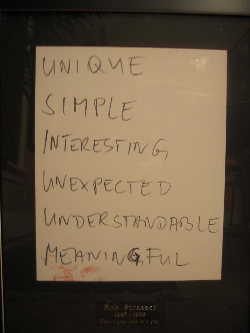Just like all that stuff you do on a computer – that used to
be done with pencil and paper on a drawing board – planning and collaboration
was done in analog. Index cards on a corkboard / comps taped up, and then the
evolution to Post-its® on a wall.
I believe that’s the way it should be done – now. Any big
project (read: expensive/time consuming/massive possibilities to final product)
needs everyone working together – collaboratively.
As I am a HUGE proponent of getting a handle on the costs
and time associated with a project – up front,
and getting a client to sign-off prior to start-work, I’m also a huge proponent
of awe-inspiring creative.
The other day I wrote
(which is probably a Duh! moment for many)
about gathering everyone together and fleshing out ideas. As well as taking into
consideration – cost, talent, availability, technology – before presenting to the client. But the article
I referred to in my post made me realize that perhaps only the creative is
being fleshed-out, but not the mechanics of production.
Call me crazy, but as a project manager (or producer) I see
my role as one who not only ensures your fabulous ideas get done (along with
everything else in the agency), but that we make money.
That’s how we stay in
business.
I love great creative and never want to compromise it
because someone didn’t do their homework. Or worse, says yes to the client, and
tries to figure out execution later.
Sometimes clients – even though the ideas are innovative,
original, and truly awesome – don’t have the money to do what you designed.
You spent the time, figured out how to execute, gathered the
best minds/talent/tools, and everyone loves it. But it costs too much. Finding
out monetary limitations after-the-fact
is no way to do business.
Therein lies the problem. You both want it so much. No
money. How do you cut a little out here and there and still retain everything
you both want?
Who takes the hit? Great ideas need to be funded. You either
cut, or you (and your vendors) and your client each take a share of the hit.
Not to mention, as an agency, you have bills to pay and
other clients to tend to. And that *other* work may not be as exciting or
innovative – but it does pay the bills. And you do like all of your clients.
This is the reality of true collaboration – everyone needs
to be in the room. Including me.
Check out this video of a Google Hangout
on Agile Creativity. And also check
out the Google page on Creativity Insights.
In the video, John Boiler of 72andSunny talks about
their workwall, which is exactly what it says. They pin-up their ideas,
everyone discusses, then leave/comeback and do it again. (He’s working on a
digital form of the workwall.)
The Google page has a simple list of tips on agile
creativity. There’s also a downloadable version. I especially like what Rei
Inamoto of AKQA has to say about a fast (four hour) cycle of
briefing/concepting/presenting. More time doesn’t mean better creative.
John Boiler states that he wants to take their workwall to a 2.0-version - make it digital. I'll have to contact him to see if they are there yet, because I still like the idea of literally being in one room. The interaction is immediate and everyone is hearing what's being said at the same time. How do you get that with an online environment. Is everyone truly engaged in the moment?
The bottom line: we do need to ensure whatever we create
can be done, and the client can pay for it, and that there are actually enough
hours in the day. And we know that throwing more bodies at a project doesn’t
mean it gets done faster – so don’t even go there.
What do you think? How does your agency handle innovative
solutions AND ensure they can be done – on time, in budget, and super awesomely
without compromise?




